Psychosocial Assessment of Diabetes Implications for Horizon City
VerifiedAdded on 2022/12/15
|9
|3645
|78
Report
AI Summary
This report presents a comprehensive psychosocial assessment of the City of Horizon, focusing on the implications of diabetes for the community. It begins with an introduction to Horizon, its location, industry, and key characteristics, followed by a psychosocial appraisal that examines social, cultural, and mental factors affecting community health. The report then investigates the social determinants of well-being, exploring health issues related to socioeconomic challenges and healthcare access. It also highlights the role of registered nurses in health care development, emphasizing strategies for enablement, promotion, and intervention in managing diabetes within the community, referencing the Ottawa Charter for Health Promotion and Registered Nurse Standards for Practice. The report analyzes the prevalence of diabetes, its contributing factors like obesity and physical inactivity, and the need for increased healthcare services and professional support. The report concludes by summarizing key findings and emphasizing the importance of addressing diabetes through community-based strategies and nursing interventions.
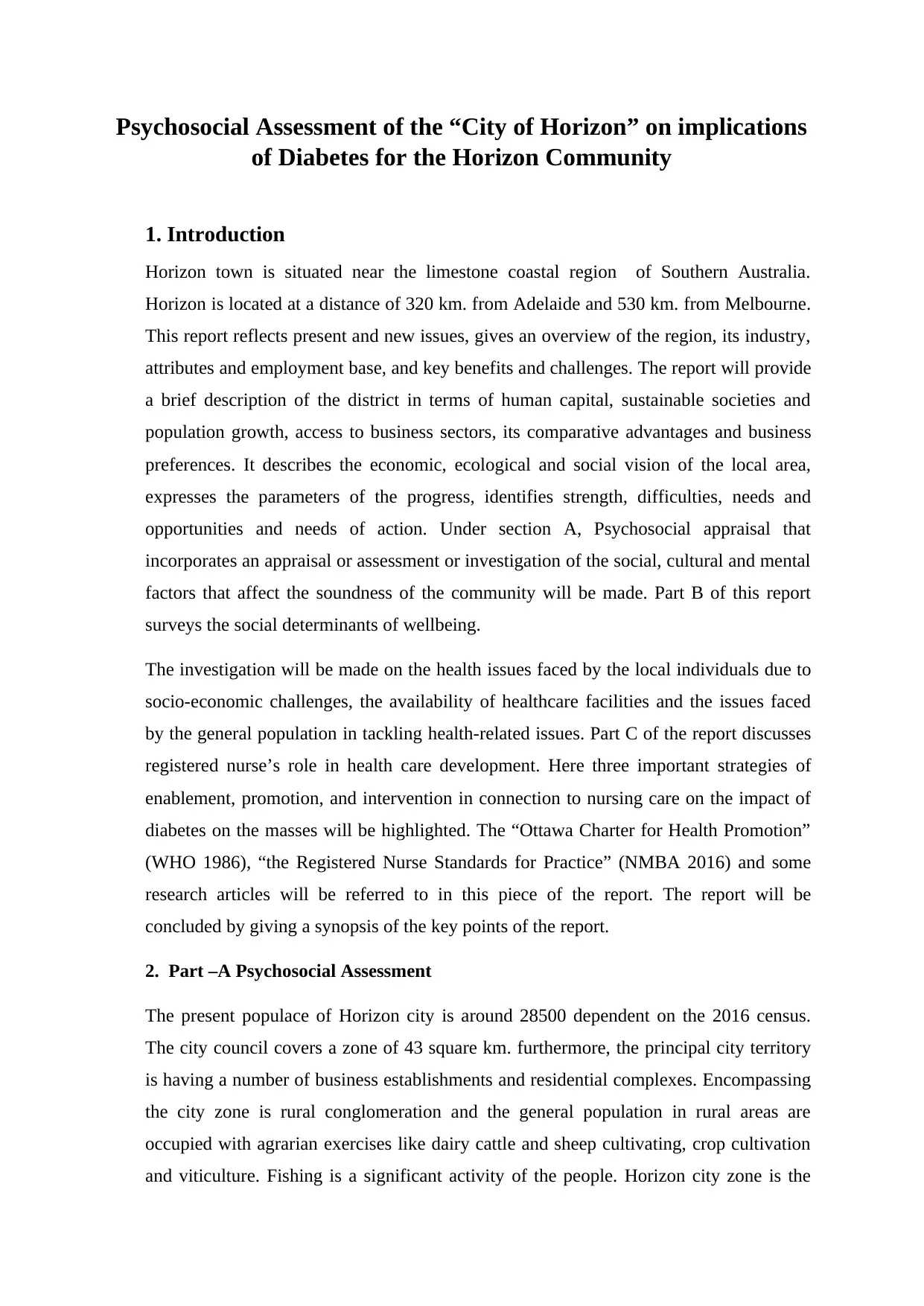
Psychosocial Assessment of the “City of Horizon” on implications
of Diabetes for the Horizon Community
1. Introduction
Horizon town is situated near the limestone coastal region of Southern Australia.
Horizon is located at a distance of 320 km. from Adelaide and 530 km. from Melbourne.
This report reflects present and new issues, gives an overview of the region, its industry,
attributes and employment base, and key benefits and challenges. The report will provide
a brief description of the district in terms of human capital, sustainable societies and
population growth, access to business sectors, its comparative advantages and business
preferences. It describes the economic, ecological and social vision of the local area,
expresses the parameters of the progress, identifies strength, difficulties, needs and
opportunities and needs of action. Under section A, Psychosocial appraisal that
incorporates an appraisal or assessment or investigation of the social, cultural and mental
factors that affect the soundness of the community will be made. Part B of this report
surveys the social determinants of wellbeing.
The investigation will be made on the health issues faced by the local individuals due to
socio-economic challenges, the availability of healthcare facilities and the issues faced
by the general population in tackling health-related issues. Part C of the report discusses
registered nurse’s role in health care development. Here three important strategies of
enablement, promotion, and intervention in connection to nursing care on the impact of
diabetes on the masses will be highlighted. The “Ottawa Charter for Health Promotion”
(WHO 1986), “the Registered Nurse Standards for Practice” (NMBA 2016) and some
research articles will be referred to in this piece of the report. The report will be
concluded by giving a synopsis of the key points of the report.
2. Part –A Psychosocial Assessment
The present populace of Horizon city is around 28500 dependent on the 2016 census.
The city council covers a zone of 43 square km. furthermore, the principal city territory
is having a number of business establishments and residential complexes. Encompassing
the city zone is rural conglomeration and the general population in rural areas are
occupied with agrarian exercises like dairy cattle and sheep cultivating, crop cultivation
and viticulture. Fishing is a significant activity of the people. Horizon city zone is the
of Diabetes for the Horizon Community
1. Introduction
Horizon town is situated near the limestone coastal region of Southern Australia.
Horizon is located at a distance of 320 km. from Adelaide and 530 km. from Melbourne.
This report reflects present and new issues, gives an overview of the region, its industry,
attributes and employment base, and key benefits and challenges. The report will provide
a brief description of the district in terms of human capital, sustainable societies and
population growth, access to business sectors, its comparative advantages and business
preferences. It describes the economic, ecological and social vision of the local area,
expresses the parameters of the progress, identifies strength, difficulties, needs and
opportunities and needs of action. Under section A, Psychosocial appraisal that
incorporates an appraisal or assessment or investigation of the social, cultural and mental
factors that affect the soundness of the community will be made. Part B of this report
surveys the social determinants of wellbeing.
The investigation will be made on the health issues faced by the local individuals due to
socio-economic challenges, the availability of healthcare facilities and the issues faced
by the general population in tackling health-related issues. Part C of the report discusses
registered nurse’s role in health care development. Here three important strategies of
enablement, promotion, and intervention in connection to nursing care on the impact of
diabetes on the masses will be highlighted. The “Ottawa Charter for Health Promotion”
(WHO 1986), “the Registered Nurse Standards for Practice” (NMBA 2016) and some
research articles will be referred to in this piece of the report. The report will be
concluded by giving a synopsis of the key points of the report.
2. Part –A Psychosocial Assessment
The present populace of Horizon city is around 28500 dependent on the 2016 census.
The city council covers a zone of 43 square km. furthermore, the principal city territory
is having a number of business establishments and residential complexes. Encompassing
the city zone is rural conglomeration and the general population in rural areas are
occupied with agrarian exercises like dairy cattle and sheep cultivating, crop cultivation
and viticulture. Fishing is a significant activity of the people. Horizon city zone is the
Paraphrase This Document
Need a fresh take? Get an instant paraphrase of this document with our AI Paraphraser
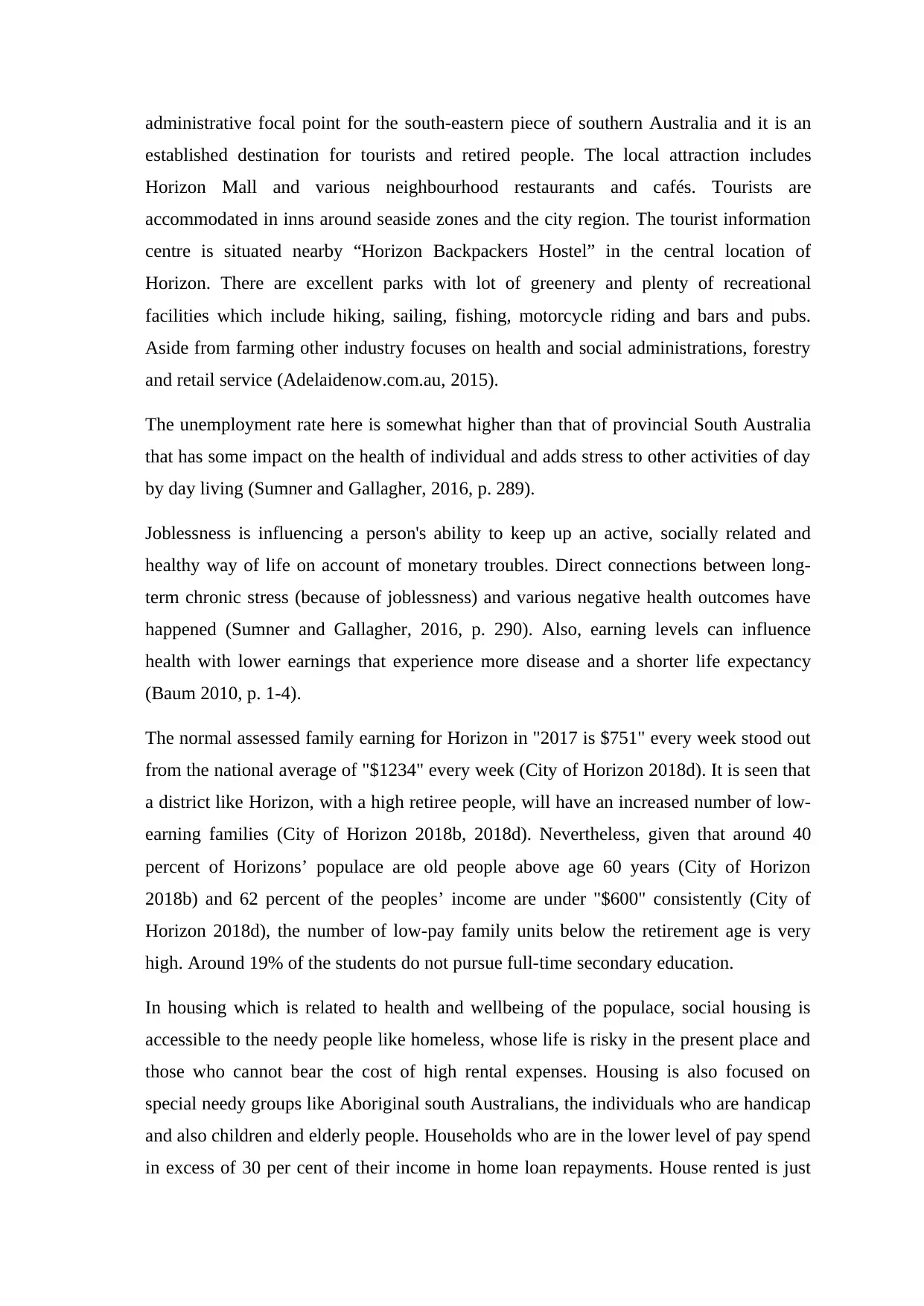
administrative focal point for the south-eastern piece of southern Australia and it is an
established destination for tourists and retired people. The local attraction includes
Horizon Mall and various neighbourhood restaurants and cafés. Tourists are
accommodated in inns around seaside zones and the city region. The tourist information
centre is situated nearby “Horizon Backpackers Hostel” in the central location of
Horizon. There are excellent parks with lot of greenery and plenty of recreational
facilities which include hiking, sailing, fishing, motorcycle riding and bars and pubs.
Aside from farming other industry focuses on health and social administrations, forestry
and retail service (Adelaidenow.com.au, 2015).
The unemployment rate here is somewhat higher than that of provincial South Australia
that has some impact on the health of individual and adds stress to other activities of day
by day living (Sumner and Gallagher, 2016, p. 289).
Joblessness is influencing a person's ability to keep up an active, socially related and
healthy way of life on account of monetary troubles. Direct connections between long-
term chronic stress (because of joblessness) and various negative health outcomes have
happened (Sumner and Gallagher, 2016, p. 290). Also, earning levels can influence
health with lower earnings that experience more disease and a shorter life expectancy
(Baum 2010, p. 1-4).
The normal assessed family earning for Horizon in "2017 is $751" every week stood out
from the national average of "$1234" every week (City of Horizon 2018d). It is seen that
a district like Horizon, with a high retiree people, will have an increased number of low-
earning families (City of Horizon 2018b, 2018d). Nevertheless, given that around 40
percent of Horizons’ populace are old people above age 60 years (City of Horizon
2018b) and 62 percent of the peoples’ income are under "$600" consistently (City of
Horizon 2018d), the number of low-pay family units below the retirement age is very
high. Around 19% of the students do not pursue full-time secondary education.
In housing which is related to health and wellbeing of the populace, social housing is
accessible to the needy people like homeless, whose life is risky in the present place and
those who cannot bear the cost of high rental expenses. Housing is also focused on
special needy groups like Aboriginal south Australians, the individuals who are handicap
and also children and elderly people. Households who are in the lower level of pay spend
in excess of 30 per cent of their income in home loan repayments. House rented is just
established destination for tourists and retired people. The local attraction includes
Horizon Mall and various neighbourhood restaurants and cafés. Tourists are
accommodated in inns around seaside zones and the city region. The tourist information
centre is situated nearby “Horizon Backpackers Hostel” in the central location of
Horizon. There are excellent parks with lot of greenery and plenty of recreational
facilities which include hiking, sailing, fishing, motorcycle riding and bars and pubs.
Aside from farming other industry focuses on health and social administrations, forestry
and retail service (Adelaidenow.com.au, 2015).
The unemployment rate here is somewhat higher than that of provincial South Australia
that has some impact on the health of individual and adds stress to other activities of day
by day living (Sumner and Gallagher, 2016, p. 289).
Joblessness is influencing a person's ability to keep up an active, socially related and
healthy way of life on account of monetary troubles. Direct connections between long-
term chronic stress (because of joblessness) and various negative health outcomes have
happened (Sumner and Gallagher, 2016, p. 290). Also, earning levels can influence
health with lower earnings that experience more disease and a shorter life expectancy
(Baum 2010, p. 1-4).
The normal assessed family earning for Horizon in "2017 is $751" every week stood out
from the national average of "$1234" every week (City of Horizon 2018d). It is seen that
a district like Horizon, with a high retiree people, will have an increased number of low-
earning families (City of Horizon 2018b, 2018d). Nevertheless, given that around 40
percent of Horizons’ populace are old people above age 60 years (City of Horizon
2018b) and 62 percent of the peoples’ income are under "$600" consistently (City of
Horizon 2018d), the number of low-pay family units below the retirement age is very
high. Around 19% of the students do not pursue full-time secondary education.
In housing which is related to health and wellbeing of the populace, social housing is
accessible to the needy people like homeless, whose life is risky in the present place and
those who cannot bear the cost of high rental expenses. Housing is also focused on
special needy groups like Aboriginal south Australians, the individuals who are handicap
and also children and elderly people. Households who are in the lower level of pay spend
in excess of 30 per cent of their income in home loan repayments. House rented is just
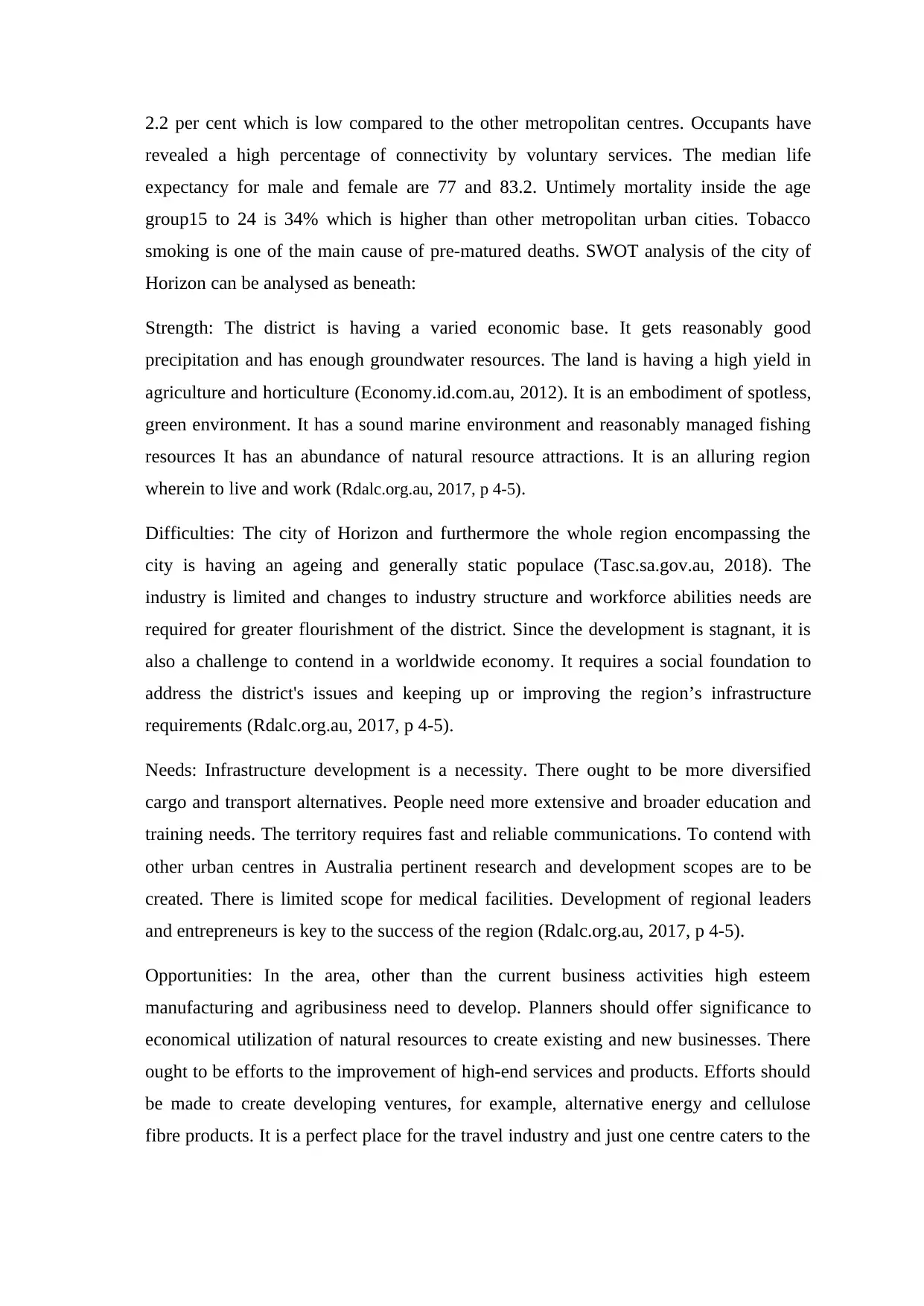
2.2 per cent which is low compared to the other metropolitan centres. Occupants have
revealed a high percentage of connectivity by voluntary services. The median life
expectancy for male and female are 77 and 83.2. Untimely mortality inside the age
group15 to 24 is 34% which is higher than other metropolitan urban cities. Tobacco
smoking is one of the main cause of pre-matured deaths. SWOT analysis of the city of
Horizon can be analysed as beneath:
Strength: The district is having a varied economic base. It gets reasonably good
precipitation and has enough groundwater resources. The land is having a high yield in
agriculture and horticulture (Economy.id.com.au, 2012). It is an embodiment of spotless,
green environment. It has a sound marine environment and reasonably managed fishing
resources It has an abundance of natural resource attractions. It is an alluring region
wherein to live and work (Rdalc.org.au, 2017, p 4-5).
Difficulties: The city of Horizon and furthermore the whole region encompassing the
city is having an ageing and generally static populace (Tasc.sa.gov.au, 2018). The
industry is limited and changes to industry structure and workforce abilities needs are
required for greater flourishment of the district. Since the development is stagnant, it is
also a challenge to contend in a worldwide economy. It requires a social foundation to
address the district's issues and keeping up or improving the region’s infrastructure
requirements (Rdalc.org.au, 2017, p 4-5).
Needs: Infrastructure development is a necessity. There ought to be more diversified
cargo and transport alternatives. People need more extensive and broader education and
training needs. The territory requires fast and reliable communications. To contend with
other urban centres in Australia pertinent research and development scopes are to be
created. There is limited scope for medical facilities. Development of regional leaders
and entrepreneurs is key to the success of the region (Rdalc.org.au, 2017, p 4-5).
Opportunities: In the area, other than the current business activities high esteem
manufacturing and agribusiness need to develop. Planners should offer significance to
economical utilization of natural resources to create existing and new businesses. There
ought to be efforts to the improvement of high-end services and products. Efforts should
be made to create developing ventures, for example, alternative energy and cellulose
fibre products. It is a perfect place for the travel industry and just one centre caters to the
revealed a high percentage of connectivity by voluntary services. The median life
expectancy for male and female are 77 and 83.2. Untimely mortality inside the age
group15 to 24 is 34% which is higher than other metropolitan urban cities. Tobacco
smoking is one of the main cause of pre-matured deaths. SWOT analysis of the city of
Horizon can be analysed as beneath:
Strength: The district is having a varied economic base. It gets reasonably good
precipitation and has enough groundwater resources. The land is having a high yield in
agriculture and horticulture (Economy.id.com.au, 2012). It is an embodiment of spotless,
green environment. It has a sound marine environment and reasonably managed fishing
resources It has an abundance of natural resource attractions. It is an alluring region
wherein to live and work (Rdalc.org.au, 2017, p 4-5).
Difficulties: The city of Horizon and furthermore the whole region encompassing the
city is having an ageing and generally static populace (Tasc.sa.gov.au, 2018). The
industry is limited and changes to industry structure and workforce abilities needs are
required for greater flourishment of the district. Since the development is stagnant, it is
also a challenge to contend in a worldwide economy. It requires a social foundation to
address the district's issues and keeping up or improving the region’s infrastructure
requirements (Rdalc.org.au, 2017, p 4-5).
Needs: Infrastructure development is a necessity. There ought to be more diversified
cargo and transport alternatives. People need more extensive and broader education and
training needs. The territory requires fast and reliable communications. To contend with
other urban centres in Australia pertinent research and development scopes are to be
created. There is limited scope for medical facilities. Development of regional leaders
and entrepreneurs is key to the success of the region (Rdalc.org.au, 2017, p 4-5).
Opportunities: In the area, other than the current business activities high esteem
manufacturing and agribusiness need to develop. Planners should offer significance to
economical utilization of natural resources to create existing and new businesses. There
ought to be efforts to the improvement of high-end services and products. Efforts should
be made to create developing ventures, for example, alternative energy and cellulose
fibre products. It is a perfect place for the travel industry and just one centre caters to the
⊘ This is a preview!⊘
Do you want full access?
Subscribe today to unlock all pages.

Trusted by 1+ million students worldwide
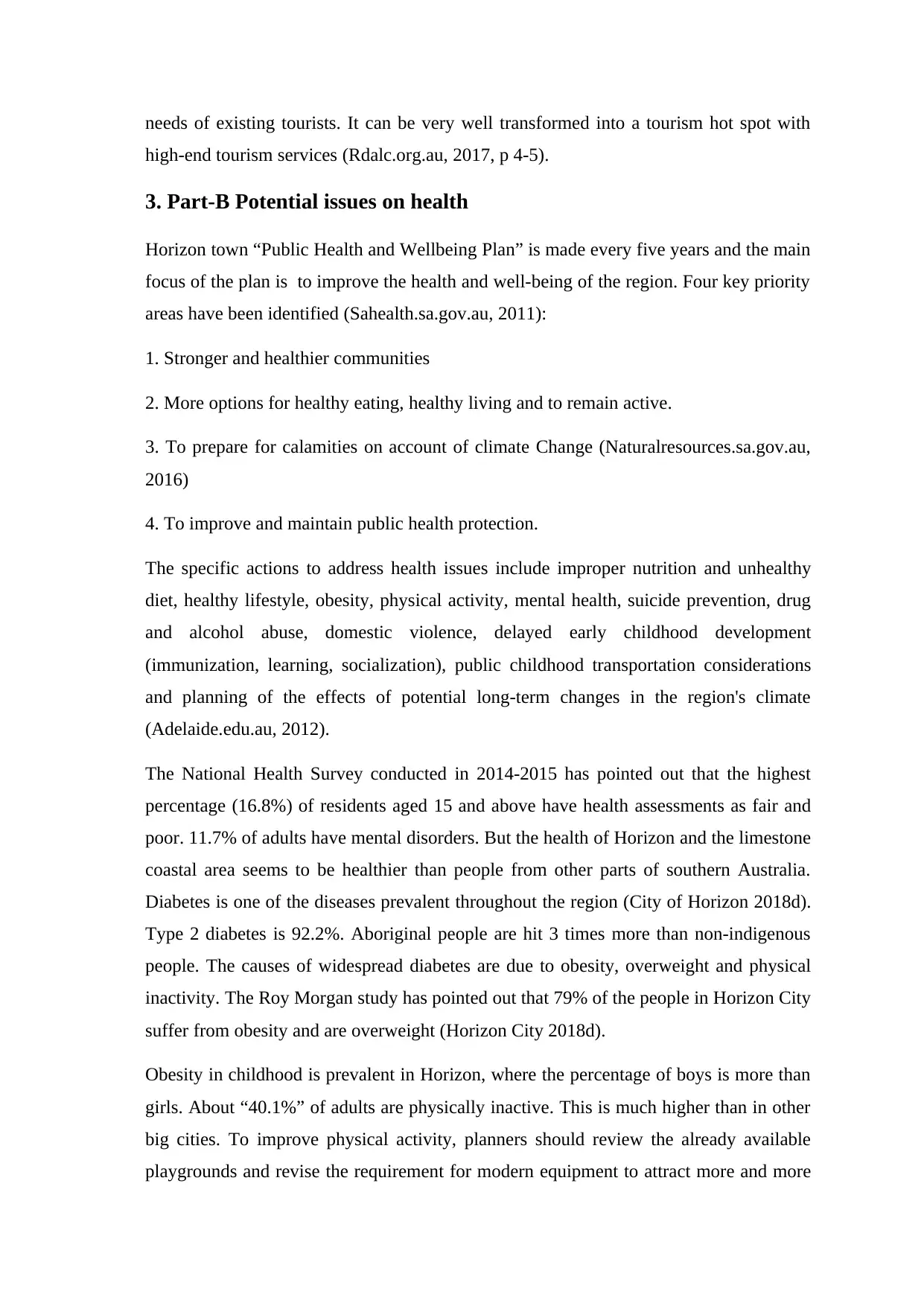
needs of existing tourists. It can be very well transformed into a tourism hot spot with
high-end tourism services (Rdalc.org.au, 2017, p 4-5).
3. Part-B Potential issues on health
Horizon town “Public Health and Wellbeing Plan” is made every five years and the main
focus of the plan is to improve the health and well-being of the region. Four key priority
areas have been identified (Sahealth.sa.gov.au, 2011):
1. Stronger and healthier communities
2. More options for healthy eating, healthy living and to remain active.
3. To prepare for calamities on account of climate Change (Naturalresources.sa.gov.au,
2016)
4. To improve and maintain public health protection.
The specific actions to address health issues include improper nutrition and unhealthy
diet, healthy lifestyle, obesity, physical activity, mental health, suicide prevention, drug
and alcohol abuse, domestic violence, delayed early childhood development
(immunization, learning, socialization), public childhood transportation considerations
and planning of the effects of potential long-term changes in the region's climate
(Adelaide.edu.au, 2012).
The National Health Survey conducted in 2014-2015 has pointed out that the highest
percentage (16.8%) of residents aged 15 and above have health assessments as fair and
poor. 11.7% of adults have mental disorders. But the health of Horizon and the limestone
coastal area seems to be healthier than people from other parts of southern Australia.
Diabetes is one of the diseases prevalent throughout the region (City of Horizon 2018d).
Type 2 diabetes is 92.2%. Aboriginal people are hit 3 times more than non-indigenous
people. The causes of widespread diabetes are due to obesity, overweight and physical
inactivity. The Roy Morgan study has pointed out that 79% of the people in Horizon City
suffer from obesity and are overweight (Horizon City 2018d).
Obesity in childhood is prevalent in Horizon, where the percentage of boys is more than
girls. About “40.1%” of adults are physically inactive. This is much higher than in other
big cities. To improve physical activity, planners should review the already available
playgrounds and revise the requirement for modern equipment to attract more and more
high-end tourism services (Rdalc.org.au, 2017, p 4-5).
3. Part-B Potential issues on health
Horizon town “Public Health and Wellbeing Plan” is made every five years and the main
focus of the plan is to improve the health and well-being of the region. Four key priority
areas have been identified (Sahealth.sa.gov.au, 2011):
1. Stronger and healthier communities
2. More options for healthy eating, healthy living and to remain active.
3. To prepare for calamities on account of climate Change (Naturalresources.sa.gov.au,
2016)
4. To improve and maintain public health protection.
The specific actions to address health issues include improper nutrition and unhealthy
diet, healthy lifestyle, obesity, physical activity, mental health, suicide prevention, drug
and alcohol abuse, domestic violence, delayed early childhood development
(immunization, learning, socialization), public childhood transportation considerations
and planning of the effects of potential long-term changes in the region's climate
(Adelaide.edu.au, 2012).
The National Health Survey conducted in 2014-2015 has pointed out that the highest
percentage (16.8%) of residents aged 15 and above have health assessments as fair and
poor. 11.7% of adults have mental disorders. But the health of Horizon and the limestone
coastal area seems to be healthier than people from other parts of southern Australia.
Diabetes is one of the diseases prevalent throughout the region (City of Horizon 2018d).
Type 2 diabetes is 92.2%. Aboriginal people are hit 3 times more than non-indigenous
people. The causes of widespread diabetes are due to obesity, overweight and physical
inactivity. The Roy Morgan study has pointed out that 79% of the people in Horizon City
suffer from obesity and are overweight (Horizon City 2018d).
Obesity in childhood is prevalent in Horizon, where the percentage of boys is more than
girls. About “40.1%” of adults are physically inactive. This is much higher than in other
big cities. To improve physical activity, planners should review the already available
playgrounds and revise the requirement for modern equipment to attract more and more
Paraphrase This Document
Need a fresh take? Get an instant paraphrase of this document with our AI Paraphraser
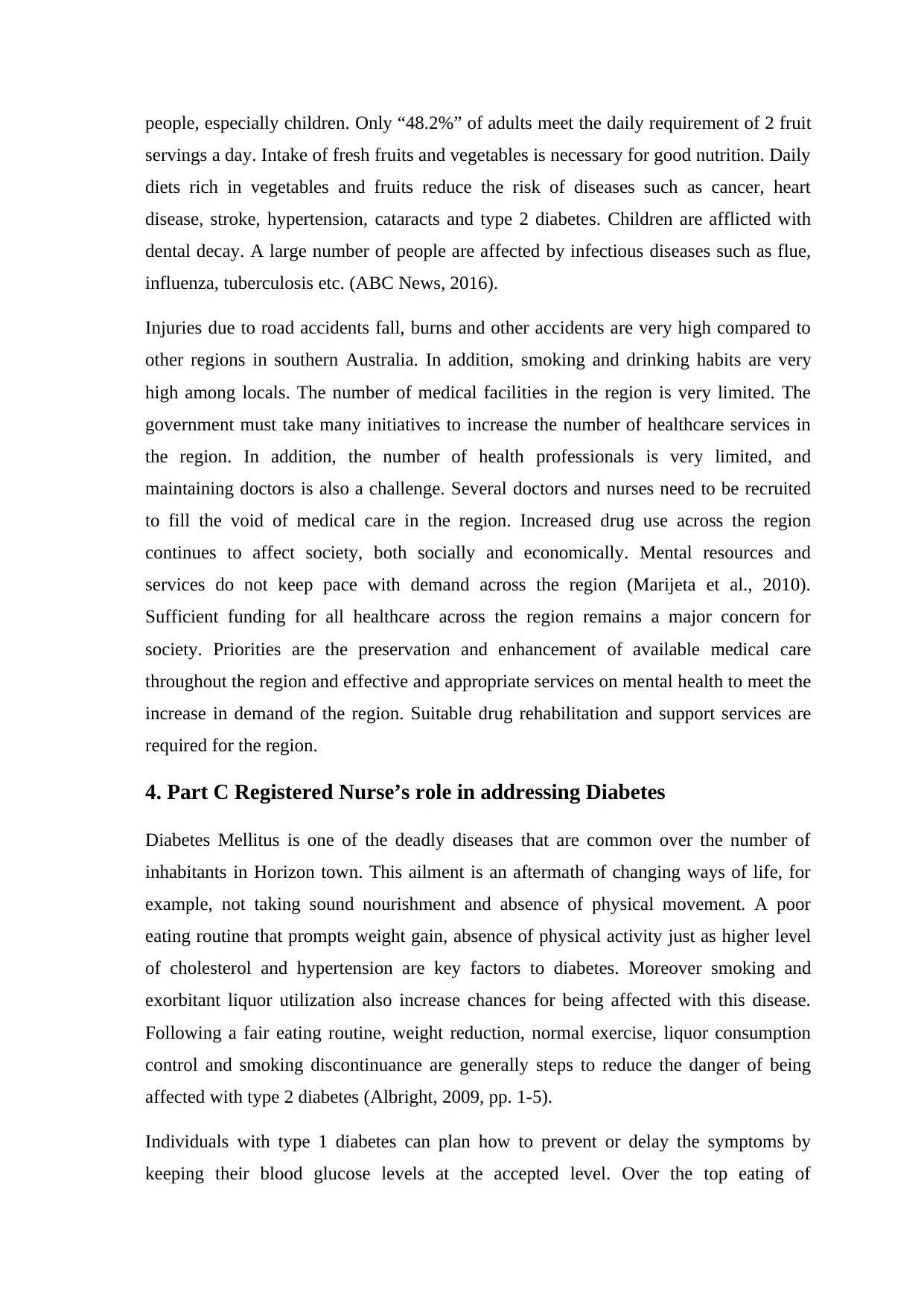
people, especially children. Only “48.2%” of adults meet the daily requirement of 2 fruit
servings a day. Intake of fresh fruits and vegetables is necessary for good nutrition. Daily
diets rich in vegetables and fruits reduce the risk of diseases such as cancer, heart
disease, stroke, hypertension, cataracts and type 2 diabetes. Children are afflicted with
dental decay. A large number of people are affected by infectious diseases such as flue,
influenza, tuberculosis etc. (ABC News, 2016).
Injuries due to road accidents fall, burns and other accidents are very high compared to
other regions in southern Australia. In addition, smoking and drinking habits are very
high among locals. The number of medical facilities in the region is very limited. The
government must take many initiatives to increase the number of healthcare services in
the region. In addition, the number of health professionals is very limited, and
maintaining doctors is also a challenge. Several doctors and nurses need to be recruited
to fill the void of medical care in the region. Increased drug use across the region
continues to affect society, both socially and economically. Mental resources and
services do not keep pace with demand across the region (Marijeta et al., 2010).
Sufficient funding for all healthcare across the region remains a major concern for
society. Priorities are the preservation and enhancement of available medical care
throughout the region and effective and appropriate services on mental health to meet the
increase in demand of the region. Suitable drug rehabilitation and support services are
required for the region.
4. Part C Registered Nurse’s role in addressing Diabetes
Diabetes Mellitus is one of the deadly diseases that are common over the number of
inhabitants in Horizon town. This ailment is an aftermath of changing ways of life, for
example, not taking sound nourishment and absence of physical movement. A poor
eating routine that prompts weight gain, absence of physical activity just as higher level
of cholesterol and hypertension are key factors to diabetes. Moreover smoking and
exorbitant liquor utilization also increase chances for being affected with this disease.
Following a fair eating routine, weight reduction, normal exercise, liquor consumption
control and smoking discontinuance are generally steps to reduce the danger of being
affected with type 2 diabetes (Albright, 2009, pp. 1-5).
Individuals with type 1 diabetes can plan how to prevent or delay the symptoms by
keeping their blood glucose levels at the accepted level. Over the top eating of
servings a day. Intake of fresh fruits and vegetables is necessary for good nutrition. Daily
diets rich in vegetables and fruits reduce the risk of diseases such as cancer, heart
disease, stroke, hypertension, cataracts and type 2 diabetes. Children are afflicted with
dental decay. A large number of people are affected by infectious diseases such as flue,
influenza, tuberculosis etc. (ABC News, 2016).
Injuries due to road accidents fall, burns and other accidents are very high compared to
other regions in southern Australia. In addition, smoking and drinking habits are very
high among locals. The number of medical facilities in the region is very limited. The
government must take many initiatives to increase the number of healthcare services in
the region. In addition, the number of health professionals is very limited, and
maintaining doctors is also a challenge. Several doctors and nurses need to be recruited
to fill the void of medical care in the region. Increased drug use across the region
continues to affect society, both socially and economically. Mental resources and
services do not keep pace with demand across the region (Marijeta et al., 2010).
Sufficient funding for all healthcare across the region remains a major concern for
society. Priorities are the preservation and enhancement of available medical care
throughout the region and effective and appropriate services on mental health to meet the
increase in demand of the region. Suitable drug rehabilitation and support services are
required for the region.
4. Part C Registered Nurse’s role in addressing Diabetes
Diabetes Mellitus is one of the deadly diseases that are common over the number of
inhabitants in Horizon town. This ailment is an aftermath of changing ways of life, for
example, not taking sound nourishment and absence of physical movement. A poor
eating routine that prompts weight gain, absence of physical activity just as higher level
of cholesterol and hypertension are key factors to diabetes. Moreover smoking and
exorbitant liquor utilization also increase chances for being affected with this disease.
Following a fair eating routine, weight reduction, normal exercise, liquor consumption
control and smoking discontinuance are generally steps to reduce the danger of being
affected with type 2 diabetes (Albright, 2009, pp. 1-5).
Individuals with type 1 diabetes can plan how to prevent or delay the symptoms by
keeping their blood glucose levels at the accepted level. Over the top eating of
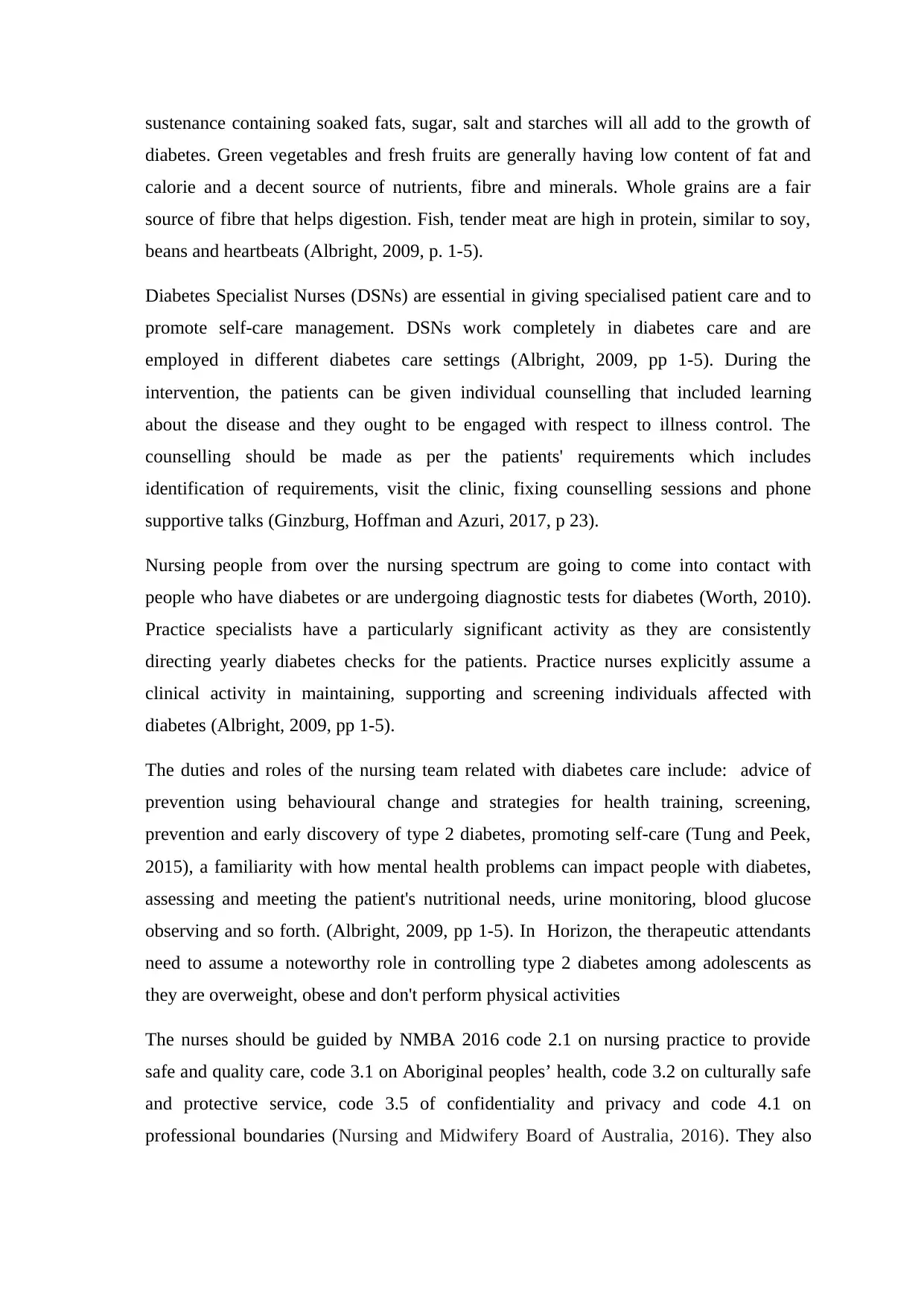
sustenance containing soaked fats, sugar, salt and starches will all add to the growth of
diabetes. Green vegetables and fresh fruits are generally having low content of fat and
calorie and a decent source of nutrients, fibre and minerals. Whole grains are a fair
source of fibre that helps digestion. Fish, tender meat are high in protein, similar to soy,
beans and heartbeats (Albright, 2009, p. 1-5).
Diabetes Specialist Nurses (DSNs) are essential in giving specialised patient care and to
promote self-care management. DSNs work completely in diabetes care and are
employed in different diabetes care settings (Albright, 2009, pp 1-5). During the
intervention, the patients can be given individual counselling that included learning
about the disease and they ought to be engaged with respect to illness control. The
counselling should be made as per the patients' requirements which includes
identification of requirements, visit the clinic, fixing counselling sessions and phone
supportive talks (Ginzburg, Hoffman and Azuri, 2017, p 23).
Nursing people from over the nursing spectrum are going to come into contact with
people who have diabetes or are undergoing diagnostic tests for diabetes (Worth, 2010).
Practice specialists have a particularly significant activity as they are consistently
directing yearly diabetes checks for the patients. Practice nurses explicitly assume a
clinical activity in maintaining, supporting and screening individuals affected with
diabetes (Albright, 2009, pp 1-5).
The duties and roles of the nursing team related with diabetes care include: advice of
prevention using behavioural change and strategies for health training, screening,
prevention and early discovery of type 2 diabetes, promoting self-care (Tung and Peek,
2015), a familiarity with how mental health problems can impact people with diabetes,
assessing and meeting the patient's nutritional needs, urine monitoring, blood glucose
observing and so forth. (Albright, 2009, pp 1-5). In Horizon, the therapeutic attendants
need to assume a noteworthy role in controlling type 2 diabetes among adolescents as
they are overweight, obese and don't perform physical activities
The nurses should be guided by NMBA 2016 code 2.1 on nursing practice to provide
safe and quality care, code 3.1 on Aboriginal peoples’ health, code 3.2 on culturally safe
and protective service, code 3.5 of confidentiality and privacy and code 4.1 on
professional boundaries (Nursing and Midwifery Board of Australia, 2016). They also
diabetes. Green vegetables and fresh fruits are generally having low content of fat and
calorie and a decent source of nutrients, fibre and minerals. Whole grains are a fair
source of fibre that helps digestion. Fish, tender meat are high in protein, similar to soy,
beans and heartbeats (Albright, 2009, p. 1-5).
Diabetes Specialist Nurses (DSNs) are essential in giving specialised patient care and to
promote self-care management. DSNs work completely in diabetes care and are
employed in different diabetes care settings (Albright, 2009, pp 1-5). During the
intervention, the patients can be given individual counselling that included learning
about the disease and they ought to be engaged with respect to illness control. The
counselling should be made as per the patients' requirements which includes
identification of requirements, visit the clinic, fixing counselling sessions and phone
supportive talks (Ginzburg, Hoffman and Azuri, 2017, p 23).
Nursing people from over the nursing spectrum are going to come into contact with
people who have diabetes or are undergoing diagnostic tests for diabetes (Worth, 2010).
Practice specialists have a particularly significant activity as they are consistently
directing yearly diabetes checks for the patients. Practice nurses explicitly assume a
clinical activity in maintaining, supporting and screening individuals affected with
diabetes (Albright, 2009, pp 1-5).
The duties and roles of the nursing team related with diabetes care include: advice of
prevention using behavioural change and strategies for health training, screening,
prevention and early discovery of type 2 diabetes, promoting self-care (Tung and Peek,
2015), a familiarity with how mental health problems can impact people with diabetes,
assessing and meeting the patient's nutritional needs, urine monitoring, blood glucose
observing and so forth. (Albright, 2009, pp 1-5). In Horizon, the therapeutic attendants
need to assume a noteworthy role in controlling type 2 diabetes among adolescents as
they are overweight, obese and don't perform physical activities
The nurses should be guided by NMBA 2016 code 2.1 on nursing practice to provide
safe and quality care, code 3.1 on Aboriginal peoples’ health, code 3.2 on culturally safe
and protective service, code 3.5 of confidentiality and privacy and code 4.1 on
professional boundaries (Nursing and Midwifery Board of Australia, 2016). They also
⊘ This is a preview!⊘
Do you want full access?
Subscribe today to unlock all pages.

Trusted by 1+ million students worldwide
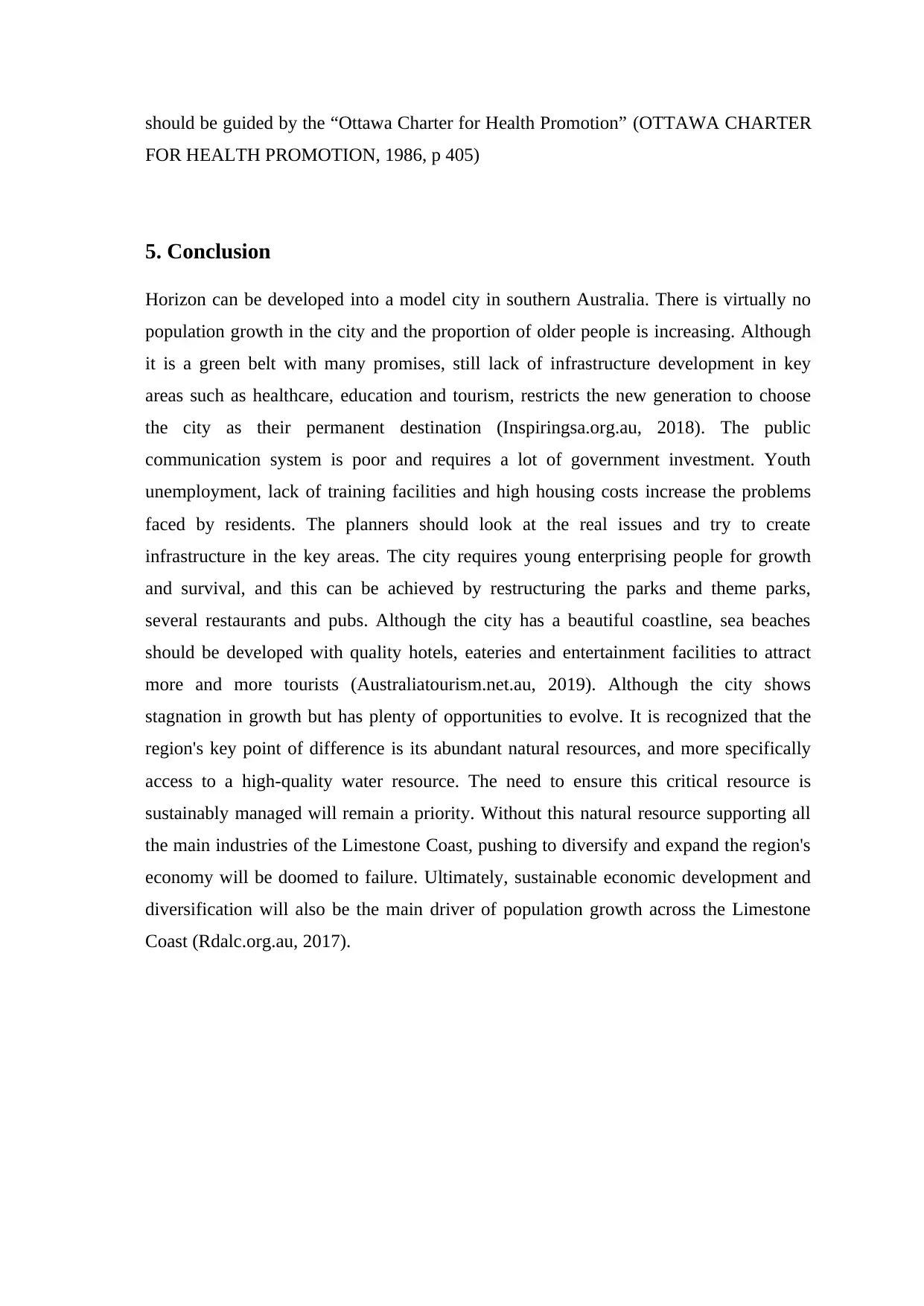
should be guided by the “Ottawa Charter for Health Promotion” (OTTAWA CHARTER
FOR HEALTH PROMOTION, 1986, p 405)
5. Conclusion
Horizon can be developed into a model city in southern Australia. There is virtually no
population growth in the city and the proportion of older people is increasing. Although
it is a green belt with many promises, still lack of infrastructure development in key
areas such as healthcare, education and tourism, restricts the new generation to choose
the city as their permanent destination (Inspiringsa.org.au, 2018). The public
communication system is poor and requires a lot of government investment. Youth
unemployment, lack of training facilities and high housing costs increase the problems
faced by residents. The planners should look at the real issues and try to create
infrastructure in the key areas. The city requires young enterprising people for growth
and survival, and this can be achieved by restructuring the parks and theme parks,
several restaurants and pubs. Although the city has a beautiful coastline, sea beaches
should be developed with quality hotels, eateries and entertainment facilities to attract
more and more tourists (Australiatourism.net.au, 2019). Although the city shows
stagnation in growth but has plenty of opportunities to evolve. It is recognized that the
region's key point of difference is its abundant natural resources, and more specifically
access to a high-quality water resource. The need to ensure this critical resource is
sustainably managed will remain a priority. Without this natural resource supporting all
the main industries of the Limestone Coast, pushing to diversify and expand the region's
economy will be doomed to failure. Ultimately, sustainable economic development and
diversification will also be the main driver of population growth across the Limestone
Coast (Rdalc.org.au, 2017).
FOR HEALTH PROMOTION, 1986, p 405)
5. Conclusion
Horizon can be developed into a model city in southern Australia. There is virtually no
population growth in the city and the proportion of older people is increasing. Although
it is a green belt with many promises, still lack of infrastructure development in key
areas such as healthcare, education and tourism, restricts the new generation to choose
the city as their permanent destination (Inspiringsa.org.au, 2018). The public
communication system is poor and requires a lot of government investment. Youth
unemployment, lack of training facilities and high housing costs increase the problems
faced by residents. The planners should look at the real issues and try to create
infrastructure in the key areas. The city requires young enterprising people for growth
and survival, and this can be achieved by restructuring the parks and theme parks,
several restaurants and pubs. Although the city has a beautiful coastline, sea beaches
should be developed with quality hotels, eateries and entertainment facilities to attract
more and more tourists (Australiatourism.net.au, 2019). Although the city shows
stagnation in growth but has plenty of opportunities to evolve. It is recognized that the
region's key point of difference is its abundant natural resources, and more specifically
access to a high-quality water resource. The need to ensure this critical resource is
sustainably managed will remain a priority. Without this natural resource supporting all
the main industries of the Limestone Coast, pushing to diversify and expand the region's
economy will be doomed to failure. Ultimately, sustainable economic development and
diversification will also be the main driver of population growth across the Limestone
Coast (Rdalc.org.au, 2017).
Paraphrase This Document
Need a fresh take? Get an instant paraphrase of this document with our AI Paraphraser
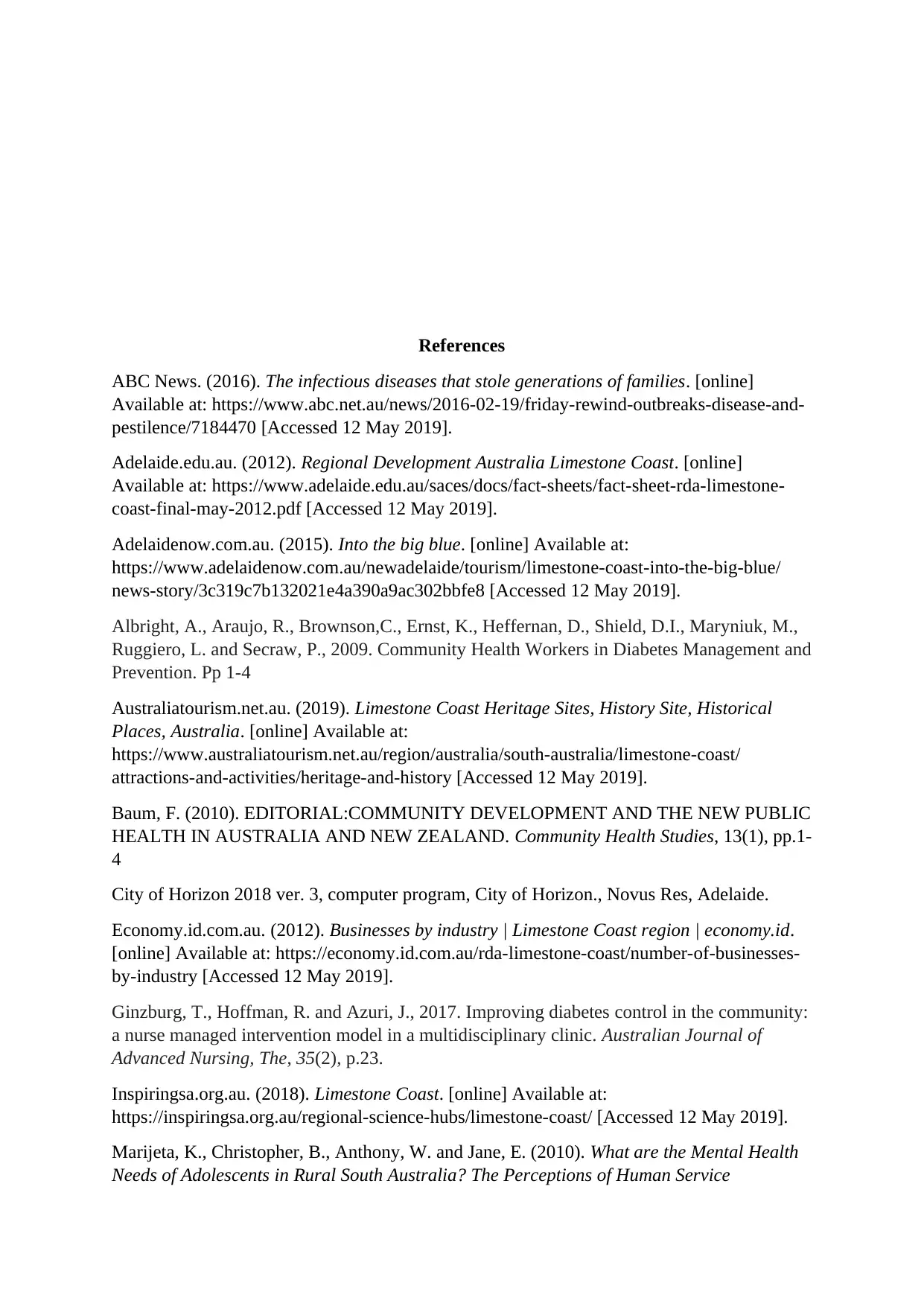
References
ABC News. (2016). The infectious diseases that stole generations of families. [online]
Available at: https://www.abc.net.au/news/2016-02-19/friday-rewind-outbreaks-disease-and-
pestilence/7184470 [Accessed 12 May 2019].
Adelaide.edu.au. (2012). Regional Development Australia Limestone Coast. [online]
Available at: https://www.adelaide.edu.au/saces/docs/fact-sheets/fact-sheet-rda-limestone-
coast-final-may-2012.pdf [Accessed 12 May 2019].
Adelaidenow.com.au. (2015). Into the big blue. [online] Available at:
https://www.adelaidenow.com.au/newadelaide/tourism/limestone-coast-into-the-big-blue/
news-story/3c319c7b132021e4a390a9ac302bbfe8 [Accessed 12 May 2019].
Albright, A., Araujo, R., Brownson,C., Ernst, K., Heffernan, D., Shield, D.I., Maryniuk, M.,
Ruggiero, L. and Secraw, P., 2009. Community Health Workers in Diabetes Management and
Prevention. Pp 1-4
Australiatourism.net.au. (2019). Limestone Coast Heritage Sites, History Site, Historical
Places, Australia. [online] Available at:
https://www.australiatourism.net.au/region/australia/south-australia/limestone-coast/
attractions-and-activities/heritage-and-history [Accessed 12 May 2019].
Baum, F. (2010). EDITORIAL:COMMUNITY DEVELOPMENT AND THE NEW PUBLIC
HEALTH IN AUSTRALIA AND NEW ZEALAND. Community Health Studies, 13(1), pp.1-
4
City of Horizon 2018 ver. 3, computer program, City of Horizon., Novus Res, Adelaide.
Economy.id.com.au. (2012). Businesses by industry | Limestone Coast region | economy.id.
[online] Available at: https://economy.id.com.au/rda-limestone-coast/number-of-businesses-
by-industry [Accessed 12 May 2019].
Ginzburg, T., Hoffman, R. and Azuri, J., 2017. Improving diabetes control in the community:
a nurse managed intervention model in a multidisciplinary clinic. Australian Journal of
Advanced Nursing, The, 35(2), p.23.
Inspiringsa.org.au. (2018). Limestone Coast. [online] Available at:
https://inspiringsa.org.au/regional-science-hubs/limestone-coast/ [Accessed 12 May 2019].
Marijeta, K., Christopher, B., Anthony, W. and Jane, E. (2010). What are the Mental Health
Needs of Adolescents in Rural South Australia? The Perceptions of Human Service
ABC News. (2016). The infectious diseases that stole generations of families. [online]
Available at: https://www.abc.net.au/news/2016-02-19/friday-rewind-outbreaks-disease-and-
pestilence/7184470 [Accessed 12 May 2019].
Adelaide.edu.au. (2012). Regional Development Australia Limestone Coast. [online]
Available at: https://www.adelaide.edu.au/saces/docs/fact-sheets/fact-sheet-rda-limestone-
coast-final-may-2012.pdf [Accessed 12 May 2019].
Adelaidenow.com.au. (2015). Into the big blue. [online] Available at:
https://www.adelaidenow.com.au/newadelaide/tourism/limestone-coast-into-the-big-blue/
news-story/3c319c7b132021e4a390a9ac302bbfe8 [Accessed 12 May 2019].
Albright, A., Araujo, R., Brownson,C., Ernst, K., Heffernan, D., Shield, D.I., Maryniuk, M.,
Ruggiero, L. and Secraw, P., 2009. Community Health Workers in Diabetes Management and
Prevention. Pp 1-4
Australiatourism.net.au. (2019). Limestone Coast Heritage Sites, History Site, Historical
Places, Australia. [online] Available at:
https://www.australiatourism.net.au/region/australia/south-australia/limestone-coast/
attractions-and-activities/heritage-and-history [Accessed 12 May 2019].
Baum, F. (2010). EDITORIAL:COMMUNITY DEVELOPMENT AND THE NEW PUBLIC
HEALTH IN AUSTRALIA AND NEW ZEALAND. Community Health Studies, 13(1), pp.1-
4
City of Horizon 2018 ver. 3, computer program, City of Horizon., Novus Res, Adelaide.
Economy.id.com.au. (2012). Businesses by industry | Limestone Coast region | economy.id.
[online] Available at: https://economy.id.com.au/rda-limestone-coast/number-of-businesses-
by-industry [Accessed 12 May 2019].
Ginzburg, T., Hoffman, R. and Azuri, J., 2017. Improving diabetes control in the community:
a nurse managed intervention model in a multidisciplinary clinic. Australian Journal of
Advanced Nursing, The, 35(2), p.23.
Inspiringsa.org.au. (2018). Limestone Coast. [online] Available at:
https://inspiringsa.org.au/regional-science-hubs/limestone-coast/ [Accessed 12 May 2019].
Marijeta, K., Christopher, B., Anthony, W. and Jane, E. (2010). What are the Mental Health
Needs of Adolescents in Rural South Australia? The Perceptions of Human Service
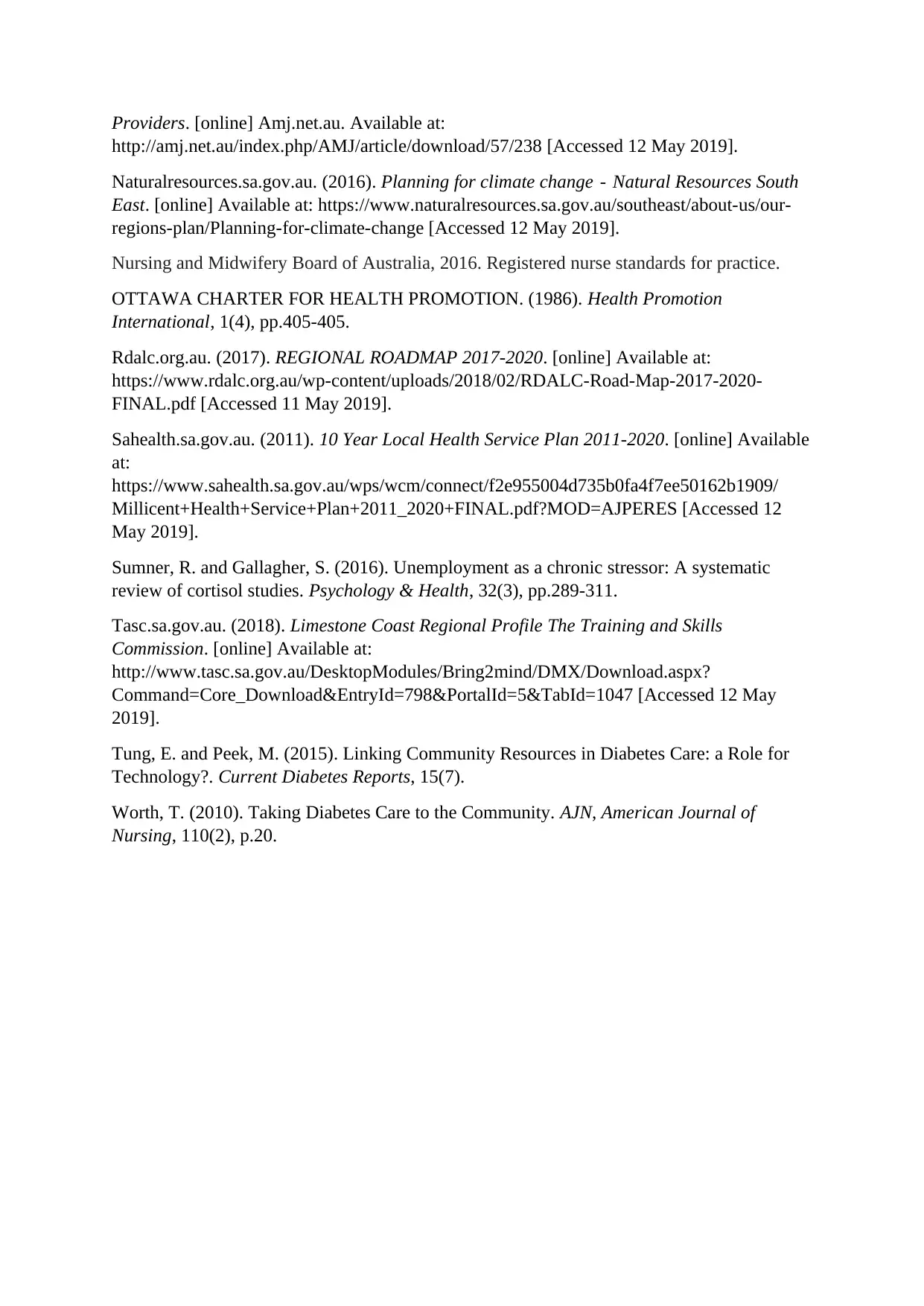
Providers. [online] Amj.net.au. Available at:
http://amj.net.au/index.php/AMJ/article/download/57/238 [Accessed 12 May 2019].
Naturalresources.sa.gov.au. (2016). Planning for climate change - Natural Resources South
East. [online] Available at: https://www.naturalresources.sa.gov.au/southeast/about-us/our-
regions-plan/Planning-for-climate-change [Accessed 12 May 2019].
Nursing and Midwifery Board of Australia, 2016. Registered nurse standards for practice.
OTTAWA CHARTER FOR HEALTH PROMOTION. (1986). Health Promotion
International, 1(4), pp.405-405.
Rdalc.org.au. (2017). REGIONAL ROADMAP 2017-2020. [online] Available at:
https://www.rdalc.org.au/wp-content/uploads/2018/02/RDALC-Road-Map-2017-2020-
FINAL.pdf [Accessed 11 May 2019].
Sahealth.sa.gov.au. (2011). 10 Year Local Health Service Plan 2011-2020. [online] Available
at:
https://www.sahealth.sa.gov.au/wps/wcm/connect/f2e955004d735b0fa4f7ee50162b1909/
Millicent+Health+Service+Plan+2011_2020+FINAL.pdf?MOD=AJPERES [Accessed 12
May 2019].
Sumner, R. and Gallagher, S. (2016). Unemployment as a chronic stressor: A systematic
review of cortisol studies. Psychology & Health, 32(3), pp.289-311.
Tasc.sa.gov.au. (2018). Limestone Coast Regional Profile The Training and Skills
Commission. [online] Available at:
http://www.tasc.sa.gov.au/DesktopModules/Bring2mind/DMX/Download.aspx?
Command=Core_Download&EntryId=798&PortalId=5&TabId=1047 [Accessed 12 May
2019].
Tung, E. and Peek, M. (2015). Linking Community Resources in Diabetes Care: a Role for
Technology?. Current Diabetes Reports, 15(7).
Worth, T. (2010). Taking Diabetes Care to the Community. AJN, American Journal of
Nursing, 110(2), p.20.
http://amj.net.au/index.php/AMJ/article/download/57/238 [Accessed 12 May 2019].
Naturalresources.sa.gov.au. (2016). Planning for climate change - Natural Resources South
East. [online] Available at: https://www.naturalresources.sa.gov.au/southeast/about-us/our-
regions-plan/Planning-for-climate-change [Accessed 12 May 2019].
Nursing and Midwifery Board of Australia, 2016. Registered nurse standards for practice.
OTTAWA CHARTER FOR HEALTH PROMOTION. (1986). Health Promotion
International, 1(4), pp.405-405.
Rdalc.org.au. (2017). REGIONAL ROADMAP 2017-2020. [online] Available at:
https://www.rdalc.org.au/wp-content/uploads/2018/02/RDALC-Road-Map-2017-2020-
FINAL.pdf [Accessed 11 May 2019].
Sahealth.sa.gov.au. (2011). 10 Year Local Health Service Plan 2011-2020. [online] Available
at:
https://www.sahealth.sa.gov.au/wps/wcm/connect/f2e955004d735b0fa4f7ee50162b1909/
Millicent+Health+Service+Plan+2011_2020+FINAL.pdf?MOD=AJPERES [Accessed 12
May 2019].
Sumner, R. and Gallagher, S. (2016). Unemployment as a chronic stressor: A systematic
review of cortisol studies. Psychology & Health, 32(3), pp.289-311.
Tasc.sa.gov.au. (2018). Limestone Coast Regional Profile The Training and Skills
Commission. [online] Available at:
http://www.tasc.sa.gov.au/DesktopModules/Bring2mind/DMX/Download.aspx?
Command=Core_Download&EntryId=798&PortalId=5&TabId=1047 [Accessed 12 May
2019].
Tung, E. and Peek, M. (2015). Linking Community Resources in Diabetes Care: a Role for
Technology?. Current Diabetes Reports, 15(7).
Worth, T. (2010). Taking Diabetes Care to the Community. AJN, American Journal of
Nursing, 110(2), p.20.
⊘ This is a preview!⊘
Do you want full access?
Subscribe today to unlock all pages.

Trusted by 1+ million students worldwide
1 out of 9
Related Documents
Your All-in-One AI-Powered Toolkit for Academic Success.
+13062052269
info@desklib.com
Available 24*7 on WhatsApp / Email
![[object Object]](/_next/static/media/star-bottom.7253800d.svg)
Unlock your academic potential
Copyright © 2020–2025 A2Z Services. All Rights Reserved. Developed and managed by ZUCOL.




